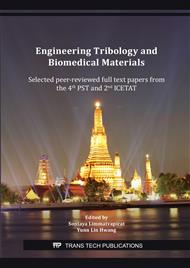[1]
J. Meyle, I. Chapple, Molecular aspects of the pathogenesis of periodontitis, Periodontol. 2000. 69 (2015) 7–17.
DOI: 10.1111/prd.12104
Google Scholar
[2]
F.A. Carranza, P.M. Camargo, The periodontal pocket, in: M.G. Newman, H.H. Takei, P.R. Klokkevold, F.A. Carranza, Carranza's Clinical Periodontology, 12th edition, Elsevier Saunders, 2015, pp.277-289.
DOI: 10.1016/b978-1-4377-0416-7.00110-4
Google Scholar
[3]
K. Jepsen, S. Jepsen, Antibiotics/antimicrobials: systemic and local administration in the therapy of mild to moderately advanced periodontitis, Periodontol. 2000. 71 (2016) 82–112.
DOI: 10.1111/prd.12121
Google Scholar
[4]
R. Hirsch, H. Deng, M.N. Laohachai, Azithromycin in periodontal treatment: more than an antibiotic, J. Periodontal Res. 47 (2012) 137–148.
DOI: 10.1111/j.1600-0765.2011.01418.x
Google Scholar
[5]
N. M. Idkaidek, N. Najib, I. Salem, J. Jilani, Physiologically-Based IVIVC of Azithromycin, Am. J. Pharmacol. Sci. 2 (2014) 100–102.
DOI: 10.12691/ajps-2-6-1
Google Scholar
[6]
S. Limsitthichaikoon, B. Khampaenjiraroch, T. Damrongrungruang, W. Limphirat, S. Thapphasaraphong, A. Priprem, Topical oral wound healing potential of anthocyanin complex: animal and clinical studies, Ther. Deliv. 9 (2018) 359–374.
DOI: 10.4155/tde-2017-0123
Google Scholar
[7]
F.J. Szoka, D. Papahadjopoulos, Procedure for preparation of liposomes with large internal aqueous space and high capture by reverse-phase evaporation, Proc. Natl. Acad. Sci. USA. 75 (1978) 4194-4198.
DOI: 10.1073/pnas.75.9.4194
Google Scholar
[8]
J. Jiang, G. Oberdörster, P. Biswas, Characterization of size, surface charge, and agglomeration state of nanoparticle dispersions for toxicological studies, J. Nanoparticle Res. 11 (2009) 77–89.
DOI: 10.1007/s11051-008-9446-4
Google Scholar
[9]
T. Watanabe, W. Soeda, K. Kobayashi, M. Nagao, The pH value changes in the periodontal pockets, Bull. TOKYO Med. Dent. Univ. 43 (1996) 67–73.
Google Scholar
[10]
D. Kaushik, P. Kumar, S. Sardana, Design Development and Evaluation of Nanosuspension of Azithromycin, Int. J. Pharm. Sci. Drug Res. (2015) 384–394.
Google Scholar
[11]
P.-C. Lai, W. Ho, N. Jain, J.D. Walters, Azithromycin Concentrations in Blood and Gingival Crevicular Fluid After Systemic Administration, J. Periodontol. 82 (2011) 1582–1586.
DOI: 10.1902/jop.2011.110012
Google Scholar
[12]
S. Limsitthichaikoon, A. Priprem, T. Damrongrungruang, Niosomes Encapsulated Anthocyanins Complex Loaded in a Topical Oral Gel, Key Eng. Mater. 859 (2020) 232–238.
DOI: 10.4028/www.scientific.net/kem.859.232
Google Scholar
[13]
S. Dash, P.N. Murthy, L. Nath, P. Chowdhury, Kinetic modeling on drug release from controlled drug delivery systems, Acta Pol. Pharm. 67 (2010) 217–223.
Google Scholar


